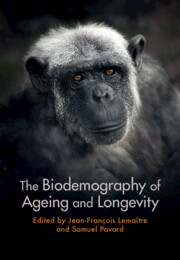Book contents
- The Biodemography of Ageing and Longevity
- The Biodemography of Ageing and Longevity
- Copyright page
- Dedication
- Contents
- Contributors
- Foreword
- Acknowledgements
- 1 The Eternal Youth of Ageing Research
- 2 Theories of Ageing across Ages
- 3 The Diversity of Longevity Metrics
- 4 The Meaning of ‘Exceptional Longevity’
- 5 The Inevitability of Senescence
- 6 The Untapped Potential of Zoo and Aquarium Data for the Comparative Biology of Ageing
- 7 Perspectives in Comparative Biology of Ageing
- 8 An Integrative Approach to Understanding Variation in the Form, Pattern and Pace of Ageing
- 9 Sex Differences in Lifespan, Ageing and Health in the Living World
- 10 Evolution of Human Reproduction, Ageing and Longevity
- 11 Lifespan and Mortality in Hunter-Gatherer and Other Subsistence Populations
- 12 Longevity in Modern Populations
- 13 Health Transition and Population Ageing
- 14 Limit of Human Longevity
- 15 Mortality Modelling at the Oldest Ages in Human Populations
- 16 Lessons from Exceptionally Long-Lived Individuals and Long-Living Families
- 17 Human Populations with Extreme Longevities
- 18 Socio-Economic Consequences of Increased Longevity in Contemporary Populations
- Index
- References
4 - The Meaning of ‘Exceptional Longevity’
A Critical Reappraisal
Published online by Cambridge University Press: 14 November 2024
- The Biodemography of Ageing and Longevity
- The Biodemography of Ageing and Longevity
- Copyright page
- Dedication
- Contents
- Contributors
- Foreword
- Acknowledgements
- 1 The Eternal Youth of Ageing Research
- 2 Theories of Ageing across Ages
- 3 The Diversity of Longevity Metrics
- 4 The Meaning of ‘Exceptional Longevity’
- 5 The Inevitability of Senescence
- 6 The Untapped Potential of Zoo and Aquarium Data for the Comparative Biology of Ageing
- 7 Perspectives in Comparative Biology of Ageing
- 8 An Integrative Approach to Understanding Variation in the Form, Pattern and Pace of Ageing
- 9 Sex Differences in Lifespan, Ageing and Health in the Living World
- 10 Evolution of Human Reproduction, Ageing and Longevity
- 11 Lifespan and Mortality in Hunter-Gatherer and Other Subsistence Populations
- 12 Longevity in Modern Populations
- 13 Health Transition and Population Ageing
- 14 Limit of Human Longevity
- 15 Mortality Modelling at the Oldest Ages in Human Populations
- 16 Lessons from Exceptionally Long-Lived Individuals and Long-Living Families
- 17 Human Populations with Extreme Longevities
- 18 Socio-Economic Consequences of Increased Longevity in Contemporary Populations
- Index
- References
Summary
Longevity is one of the most variable life history traits among animals, ranging from days (e.g. adult mayflies) to centuries (e.g. the Greenland shark). Based on this variability, claims that some species display exceptional longevity are regularly published. Yet determining whether a species shows exceptional longevity or not is far from an easy task. For instance, longevity is (among other traits) associated with body mass, according to an allometric relationship, and a species displaying exceptional longevity should typically break this relationship. Longevity also corresponds to a biological time measuring the speed of the life cycle (often called pace of life) and should be isometrically linked with other biological times such as developmental time or age at first reproduction. From that perspective, a species displaying exceptional longevity should break these relationships as well. However, how much the observed longevity should differ from the predicted values for a given body mass or a given pace of life to be labelled as exceptional is fuzzy. Similarly, what is the threshold age at which a set of individuals displaying exceptional longevities can be identified? The aim of this chapter is to provide a critical reappraisal of some statistical methods used so far to determine whether a species or an individual shows exceptional longevity and then to provide a clear roadmap to identify such species and individuals. The analyses presented in this chapter are based on demographic databases on mammals and some exceptionally detailed case studies (on medflies, rhesus macaques and mole rats) at the individual level.
- Type
- Chapter
- Information
- The Biodemography of Ageing and Longevity , pp. 48 - 68Publisher: Cambridge University PressPrint publication year: 2024

